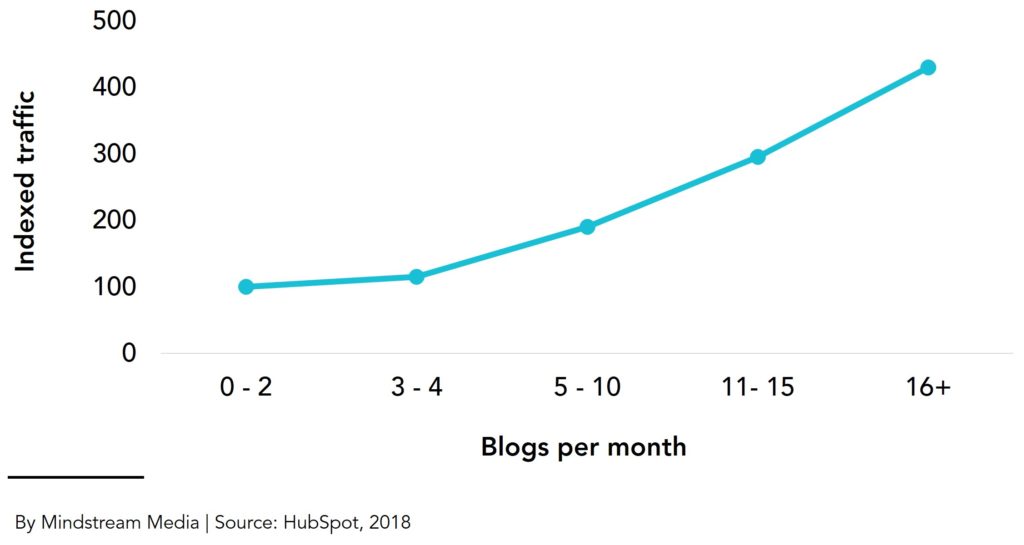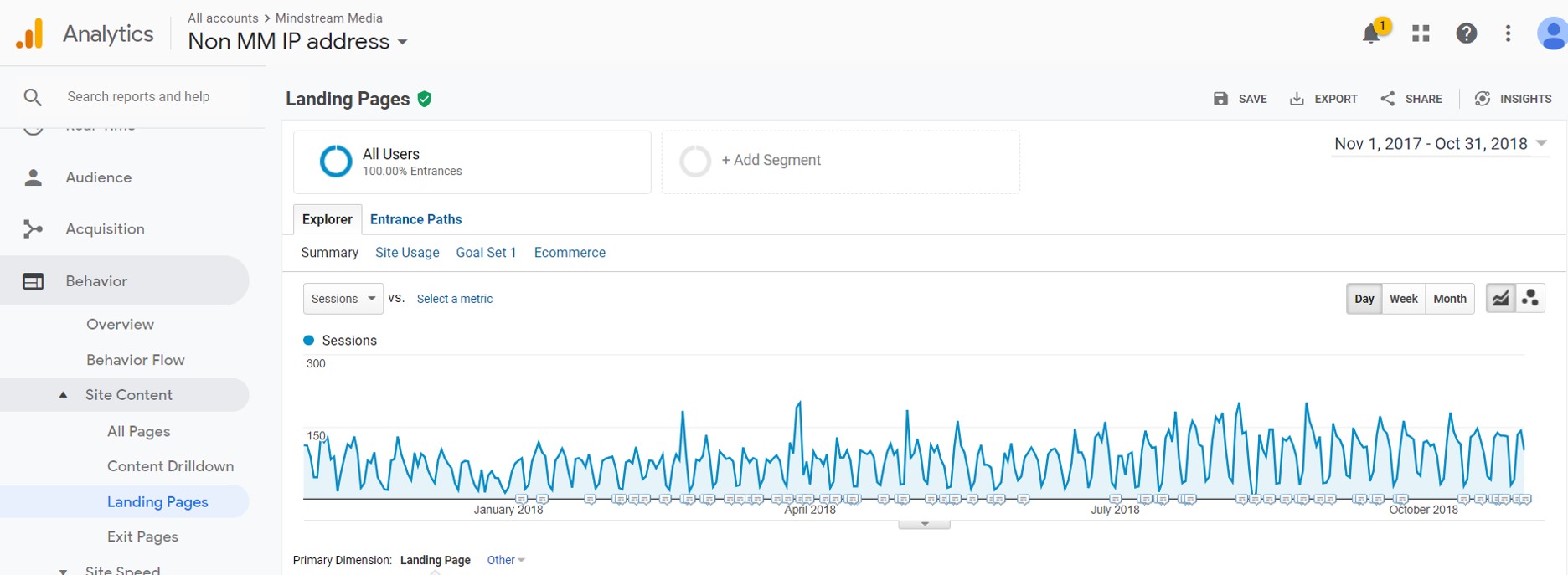The takeaway: There are more than 3 million blog posts published on the internet every day. With that volume, it’s important to develop blog topics that your audiences will actually want to read. This post will help you come up with blog topics that engage target audiences and drive traffic to your website.
Blogging has become a powerful tool in many brands’ marketing repertoire. Publishing blog posts on a regular basis can be an effective way for brands to share their story, answer their customers’ questions, engage with their target audiences and drive traffic to their website.
At first glance, it would appear the more blogs a brand creates, the more traffic their website receives. According to a study by HubSpot, companies that publish more than 16 blog posts per month receive almost 3.5 times more traffic than those that published less than four posts a month.

But that doesn’t mean your brand can churn out subpar blog posts and expect to drive boatloads of traffic to your site. In the blogging world, competition is too fierce for mediocrity. Brands, agencies, publishers and individuals publish more than 3 million blog posts each day. With that congested of a landscape, you need to make sure your brand is publishing high-quality posts that cut through the clutter, grab people’s attention and actually drive traffic to your site.
Creating posts that drive traffic is a complicated process that starts with a basic – albeit demanding – first step: identifying topics that people actually give a damn about. In this post, we’ll cover some of the steps required to get inside your target audiences’ heads to find out what topics they need, want and care to read about.
Create a list of general blog topics
Get the process started by using ideas and thoughts off the top of your head. Once you have a solid base of ideas, continue to refine and polish your list to identify the topics that your target audiences are most likely to read.
Step No. 1: Brainstorm
Like any other brainstorm, this process should happen organically. List out all of the topics you can think of related to your brand and its products and services. There’s no such thing as a bad idea here, the important thing is to just get all your ideas written out.
Step No. 2: Develop buyer personas
Next, beef up your original list by researching your target audiences to find out what kind of content they want to see from your brand. If you haven’t already, this is a great time to create buyer personas (i.e., generalized representations of your brand’s ideal customers). If you need help building these out, here’s a helpful guide to get you started.
Buyer personas will help you answer key questions that will generate ideas for your list of blog topics.
- What questions do your customers have about your products and services?
- What are the major pain points and challenges of your target audience?
- How do your products and services address your target audiences’ pain points and challenges?
Step No. 3: Conduct industry research
Find out what topics other brands in your industry are writing about by reading relevant blogs and publications, including your competitors’ posts. Take those topics and come up with new angles or approaches that address your specific audience’s needs and wants.
Step No. 4: Review historical data
To round out your list of general blog topics, identify top performing content pieces your brand created in the past. To do this, you’ll need to set up a website traffic tool like Google Analytics. Dive into the data to identify content pieces that resonated with audiences and look for opportunities to repurpose that content like:
- Refreshing old blog posts by updating stats and data and incorporating new trends
- Elaborating on topics that you just touched on in previous posts
- Repurposing related blog posts into a longer form piece like an e-book

Refine your list of blog topics
It’s important to keep your blog topic ideas focused. The last thing you want is an amalgamation of semi-related topics stuffed into a single post. Instead, try to narrow down the focus of each post to a central idea. For example, if your company sells iPhones, instead of writing a post like “10 amazing features on your iPhone” write something more specific like “The 10 best iPhone parental control features.”
Step No. 1: Conduct keyword research
Start by finding specific keywords for each topic. Focusing your blog topics on specific keywords will not only keep your post focused, but you’ll have the added benefit of optimizing the content for related Google searches.
To conduct keyword research, head to Google Ads and pull up their Keyword Planner tool (you’ll need to set up a Google Ads account to access the tool). From there, start entering in your general topics and related terms to identify popular relevant search terms.
For each topic, identify one or two keywords to focus your blog post on. Any more than that and the blog will likely lose focus. Choose keywords based on:
- The keyword’s length: longer-tail keywords typically have less competition in search results
- The keyword’s search volume: choose popular terms that your target audiences are likely to search for
- The keyword’s seasonality: don’t just use average search volume, look at the popularity by month to identify seasonal trends to write about
Step No. 2: Find top performing topics
Now that you’ve set yourself up for a search engine optimized post, it’s time to make sure the content will resonate on social media. To get an idea of the most popular topics on social media, you can use a freemium tool like Buzzsumo. The free version of Buzzsumo can help you find related top performing content by entering your general topic into the tool’s search bar.

Related – 10 of the Best Free Tools to Help You Produce Killer Online Content
Organize your blog topics strategically
As you gather ideas for blog post topics, it’s important to keep them organized so you can strategically create and publish the content. One way to do this is to keep a running list of blog topic ideas in a spreadsheet that you can turn into a de facto content calendar.
Step No. 1: Build out a content calendar
Turn your list of ideas into an organized calendar that will guide your content creation. An effective tool for organizing this list is Google Sheets. With Google Sheets, you can lay out upcoming content pieces in a way that’s easy to digest and edit while planning out details like post date, focus keyword, working title, additional notes, etc.

If you’d like to start building out your own content calendar, you can copy this Google Sheet into your own Google Drive account.
Step No. 2: Develop topic clusters
One way to build out your content calendar is using the topic-cluster method. This method makes it easy for search engines to understand that the content is related, crawl individual pages and display the pages in relevant search results. Here’s how it works:
- Determine an overarching topic you want to write about to act as your “pillar content”
- Develop “cluster content” – blogs and other pieces about subtopics related to the pillar content
- Create a pillar page to act as the main content hub for an overarching topic that links out to the previously published cluster content
Once you’ve gotten all your ideas laid out and organized, it’s time to start actually writing blog posts. Make sure to subscribe to our blog for more tips on best practices for creating blog posts.


